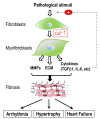Ca2+ Signaling in Cardiac Fibroblasts and Fibrosis-Associated Heart Diseases
- PMID: 31547577
- PMCID: PMC6956282
- DOI: 10.3390/jcdd6040034
Ca2+ Signaling in Cardiac Fibroblasts and Fibrosis-Associated Heart Diseases
Abstract
Cardiac fibrosis is the excessive deposition of extracellular matrix proteins by cardiac fibroblasts and myofibroblasts, and is a hallmark feature of most heart diseases, including arrhythmia, hypertrophy, and heart failure. This maladaptive process occurs in response to a variety of stimuli, including myocardial injury, inflammation, and mechanical overload. There are multiple signaling pathways and various cell types that influence the fibrogenesis cascade. Fibroblasts and myofibroblasts are central effectors. Although it is clear that Ca2+ signaling plays a vital role in this pathological process, what contributes to Ca2+ signaling in fibroblasts and myofibroblasts is still not wholly understood, chiefly because of the large and diverse number of receptors, transporters, and ion channels that influence intracellular Ca2+ signaling. Intracellular Ca2+ signals are generated by Ca2+ release from intracellular Ca2+ stores and by Ca2+ entry through a multitude of Ca2+-permeable ion channels in the plasma membrane. Over the past decade, the transient receptor potential (TRP) channels have emerged as one of the most important families of ion channels mediating Ca2+ signaling in cardiac fibroblasts. TRP channels are a superfamily of non-voltage-gated, Ca2+-permeable non-selective cation channels. Their ability to respond to various stimulating cues makes TRP channels effective sensors of the many different pathophysiological events that stimulate cardiac fibrogenesis. This review focuses on the mechanisms of Ca2+ signaling in fibroblast differentiation and fibrosis-associated heart diseases and will highlight recent advances in the understanding of the roles that TRP and other Ca2+-permeable channels play in cardiac fibrosis.
Keywords: Ca2+ signaling pathways; TRP channels; cardiac fibroblasts; cardiac fibrosis; ion channels.
Conflict of interest statement
The authors declare no conflict of interest.
Figures


Similar articles
-
Transient receptor potential (TRP) channels and cardiac fibrosis.Curr Top Med Chem. 2013;13(3):270-82. doi: 10.2174/1568026611313030005. Curr Top Med Chem. 2013. PMID: 23432060 Free PMC article. Review.
-
TRP Channels in the Heart.In: Emir TLR, editor. Neurobiology of TRP Channels. Boca Raton (FL): CRC Press/Taylor & Francis; 2017. Chapter 9. In: Emir TLR, editor. Neurobiology of TRP Channels. Boca Raton (FL): CRC Press/Taylor & Francis; 2017. Chapter 9. PMID: 29356479 Free Books & Documents. Review.
-
Regulation and Role of Store-Operated Ca2+ Entry in Cellular Proliferation.In: Kozak JA, Putney JW Jr, editors. Calcium Entry Channels in Non-Excitable Cells. Boca Raton (FL): CRC Press/Taylor & Francis; 2018. Chapter 12. In: Kozak JA, Putney JW Jr, editors. Calcium Entry Channels in Non-Excitable Cells. Boca Raton (FL): CRC Press/Taylor & Francis; 2018. Chapter 12. PMID: 30299656 Free Books & Documents. Review.
-
Emerging role of transient receptor potential (TRP) ion channels in cardiac fibroblast pathophysiology.Front Physiol. 2022 Oct 6;13:968393. doi: 10.3389/fphys.2022.968393. eCollection 2022. Front Physiol. 2022. PMID: 36277180 Free PMC article. Review.
-
Progress on role of ion channels of cardiac fibroblasts in fibrosis.Front Physiol. 2023 Mar 9;14:1138306. doi: 10.3389/fphys.2023.1138306. eCollection 2023. Front Physiol. 2023. PMID: 36969589 Free PMC article. Review.
Cited by
-
Fibroblast Growth Factor 23 Stimulates Cardiac Fibroblast Activity through Phospholipase C-Mediated Calcium Signaling.Int J Mol Sci. 2021 Dec 23;23(1):166. doi: 10.3390/ijms23010166. Int J Mol Sci. 2021. PMID: 35008591 Free PMC article.
-
Fibrotic Remodeling during Persistent Atrial Fibrillation: In Silico Investigation of the Role of Calcium for Human Atrial Myofibroblast Electrophysiology.Cells. 2021 Oct 22;10(11):2852. doi: 10.3390/cells10112852. Cells. 2021. PMID: 34831076 Free PMC article.
-
Piezo1 Channel as a Potential Target for Hindering Cardiac Fibrotic Remodeling.Int J Mol Sci. 2022 Jul 22;23(15):8065. doi: 10.3390/ijms23158065. Int J Mol Sci. 2022. PMID: 35897650 Free PMC article. Review.
-
Long QT syndrome type 3 gain-of-function of Nav1.5 increases ventricular fibroblasts proliferation and pro-fibrotic factors.Commun Biol. 2025 Feb 11;8(1):216. doi: 10.1038/s42003-025-07636-5. Commun Biol. 2025. PMID: 39934335 Free PMC article.
-
Role of Adenosine and Purinergic Receptors in Myocardial Infarction: Focus on Different Signal Transduction Pathways.Biomedicines. 2021 Feb 18;9(2):204. doi: 10.3390/biomedicines9020204. Biomedicines. 2021. PMID: 33670488 Free PMC article. Review.
References
-
- Weber K. Cardiac interstitium. In: Poole-Wilson P., Colucci W., Massie B., Chatterjee K., Coats A., editors. Heart Failure. Churchill Livingstone; New York, NY, USA: 1997. pp. 13–31.
Publication types
Grants and funding
LinkOut - more resources
Full Text Sources
Miscellaneous

